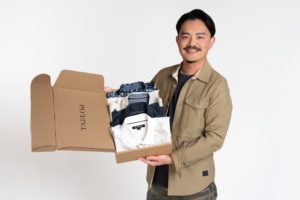When Anya Cheng decided to launch an ecommerce company, she had a distinct advantage over most other entrepreneurs: she knew her way around digital marketing after holding senior ecommerce roles at Facebook, eBay, McDonald’s and Target.
And one thing she knew was to not rush into search-engine optimization. Taking a slow approach to SEO is something she recommends to anyone who launches an online store.
“Forget about search for now. You should go back to your user journey,” Cheng, Taelor co-founder and CEO, said in an interview with Digital Commerce 360. Taelor is an apparel-subscription service for men that uses stylists and artificial intelligence to select clothes for individual customers.
Cheng, also an adjunct lecturer of product management, marketing and entrepreneurship at Northwestern University, likes to tell a story from her days at the world’s largest social network.
“When I was at Facebook, we sold Facebook Wi-Fi in different countries,” Cheng said. “We found that people don’t search for ‘Wi-Fi’ right away. They search for ‘free NBA games’ or ‘free cricket’ or ‘Netflix shows.’ When they find what they’re looking for, they realize they need good, fast internet, so they start searching for ‘fast internet.’ Then they realize that Wi-Fi is faster than the internet where they are. So they search for ‘free Wi-Fi” and they realized they couldn’t get free Wi-Fi at high speed, and they start looking at paid Wi-Fi and they heard about Facebook Wi-Fi.”
SEO is about searching for searchers

Anya Cheng of Taelor. (Photo Credit: Candice)
For a flat, $88-per-month fee, Taelor customers get up to two boxes of clothes per month. In each box are four items: dress shirts, jackets, polo shirts, henley shirts and more. Dry cleaning and shipping are free both ways, making renting and returning clothing effortless.
In 2021 when Cheng launched Taelor, she knew she needed to understand the buyer’s journey before she could understand how potential customers might find Taelor in search. And to do that, she needed to understand the potential buyers.
“The first thing to do is identify your personas,” Cheng said. “If you’re a small company, you can do this on your own” by researching and talking to industry leaders until “you get a sense of where the industry is going, where’s the opportunity.”
Next, Cheng suggests entrepreneurs interview about 20 people to understand their pain points. Then, create a survey of a few hundred people to get a sense of how broad the audience is that experiences those pain points.
Usually, this process will yield about 20 pain points and a handful of personas. Cheng advises that startups initially market to two personas at first and ignore the rest.
From there, an entrepreneur can start creating messages and positioning aimed at reaching those select personas.
Don’t get confused
At this point, the new ecommerce company is ready to optimize for search. But be cautious, Cheng advises, because it’s common for entrepreneurs to confuse their company’s value proposition with the target personas. And that will be a disaster in search.

A model poses with a Taelor subscription box. (Photo Credit: Jabbar Luo)
Taelor’s customer base is men 25 to 35 years old. Some 60% of them are single. They are heavily represented by engineers and salespeople, Cheng says and “we know they are not into fashion.”
That’s where things got tricky.
“When I first started Taelor, we realized a lot of our customers were guys who were very ambitious and aspirational, which means they were like, ‘I want to get a date.’ ‘I want to close a deal.’ ‘I want to get a better job.’ They wanted better things. They want to achieve.”
So Taelor’s first marketing campaign told potential customers they could “look good and be confident” by using the service.
“We thought it was great,” Cheng said. “It was perfect. But it didn’t work.”
It turned out that improving your appearance and boosting your confidence were the perceived needs of the target personas. But they were not value propositions that would convince them to subscribe to Taelor’s service.
After some more experimentation — using paid search to learn what terms led to conversions more quickly than she could by using organic search — Cheng found a proposition that the personas valued enough to make them buy: “No shopping. No laundry.”
Personas and the women who love them
Cheng calls herself a “mini-influencer” with more than 70,000 followers on Facebook, LinkedIn, Clubhouse and more. She’s also a constant presence at events for Asian-American entrepreneurs, women-led companies and computer engineers.
By talking to people online and at events, Cheng found a key bit of information to perfect her SEO strategy for reaching men who need a better wardrobe: women.
“Lots of women have tried a subscription service. So most of our guys were influenced by their female counterparts,” Cheng said.
Those potential subscribers, prompted by the women in their lives, do a Google search and find Taelor’s content marketing, news coverage and website.
SEO tips from a search marketer
If you already have an SEO plan in place, it’s not time to rest. There’s always more work to do with SEO.
“The first tip for any small to medium-size ecommerce company looking to improve its SEO strategy is to start with keyword research to successfully set the foundation for your digital strategy and better understand how consumers search for your products. A great trick is to use Amazon or Google Suggest,” Eric Ritter, CEO of search agency Digital Neighbor, told Digital Commerce 360. “Once you’ve clearly defined your keyword goals, set a practice to follow 2022 website best practices through under-the-hood technical SEO tools built in your CMS — whether that’s WordPress, Shopify, or something else.”
In addition, Ritter reminds entrepreneurs that “getting specific in your product descriptions is a practice that can set your business apart from the competition. Many other sites might sell similar products, but if your descriptions connect with potential customers, they will be more likely to purchase from you. Plus, as a bonus, if you pay close attention to creating detailed product descriptions, you will see an improvement in your website’s SEO.”
Ecommerce companies see the value in SEO
Retailers know that optimizing well for search pays dividends.
That’s why, as the following two graphics illustrate, search gets a large portion of marketers’ budgets.
Search never sleeps
In June 2021, Google unveiled what it called Core Web Vitals: three activities measured by how long they take to complete on a page, which the search engine said would have a profound effect on how it ranked pages:
- Largest Contentful Paint (LCP) – loading, target 2.5 seconds.
- First Input Delay (FID) – interactivity, target 100 milliseconds.
- Cumulative Layout Shift (CLS) – visual stability, target 0.1.
One year later, Search Engine Land, citing SEO platform provider BrightEdge, said retail scores have improved 58%. That’s particularly impressive given that retail sites had poor scores when Google announced the initiative, according to Search Engine Land.
Search brings success
Today, Taelor uses a search-marketing consultant who once reported to Cheng at Facebook, as well as a small team in India to optimize pages.
Her company also has a new line of business in which companies provide a Taelor subscription as a benefit for employees (Google is a customer). Taelor is also now a data analytics firm that lets clothing brands and retailers test products and predict trends based on how a product performs among subscribers.
And the finance community has noticed Taelor, too. In April, the company closed a $2.3 million pre-seed round of funding led by Bling Capital. Bling is a venture capital firm founded by Ben Ling, an early executive at Google and Meta (formerly Facebook). It has previously invested in more than 10 unicorn companies, including Lyft, Instacart and Square.
Sign up
Stay on top of the latest developments in the ecommerce industry. Sign up for a complimentary subscription to Digital Commerce 360 Retail News.
Follow us on LinkedIn, Twitter and Facebook. Be the first to know when Digital Commerce 360 publishes news content.
Favorite